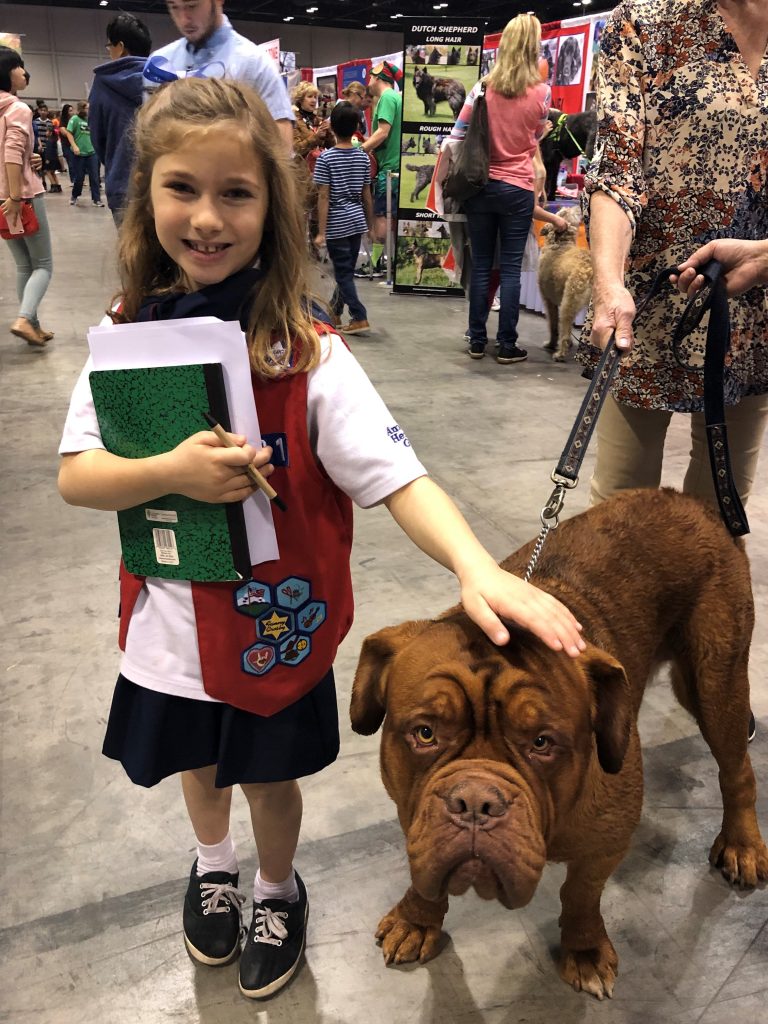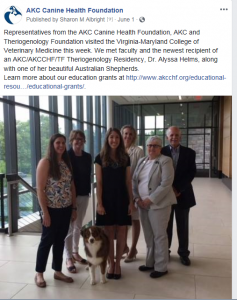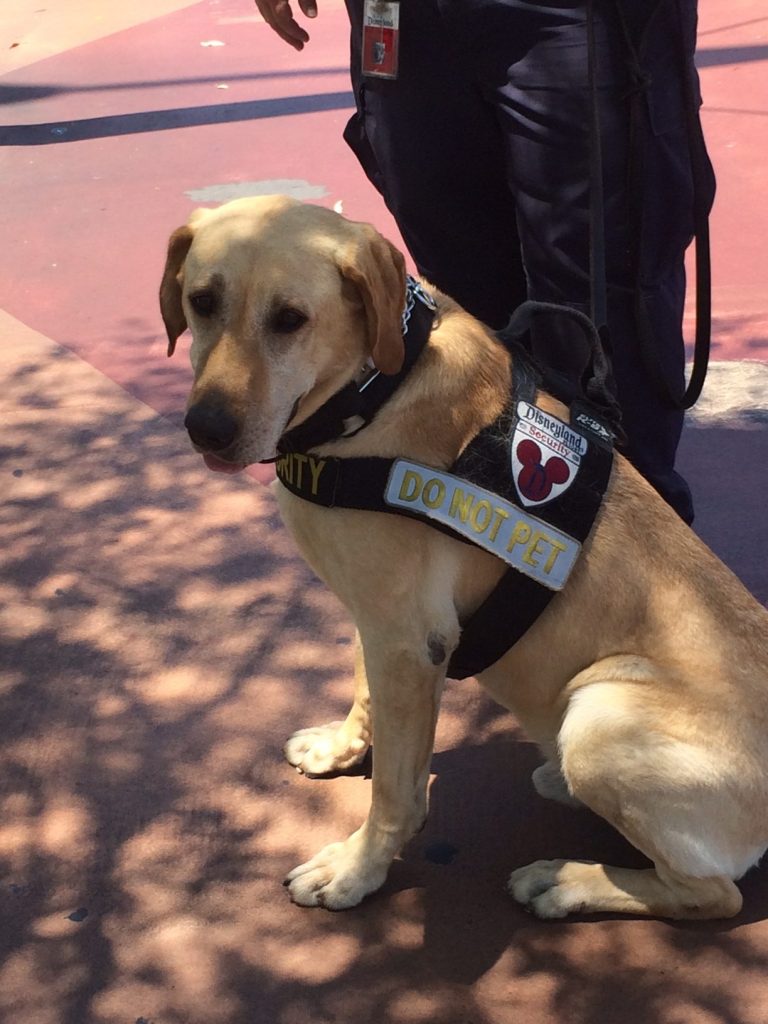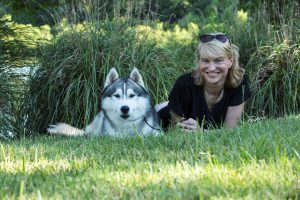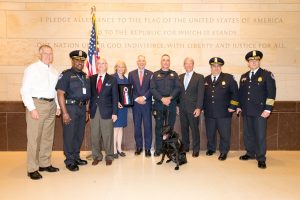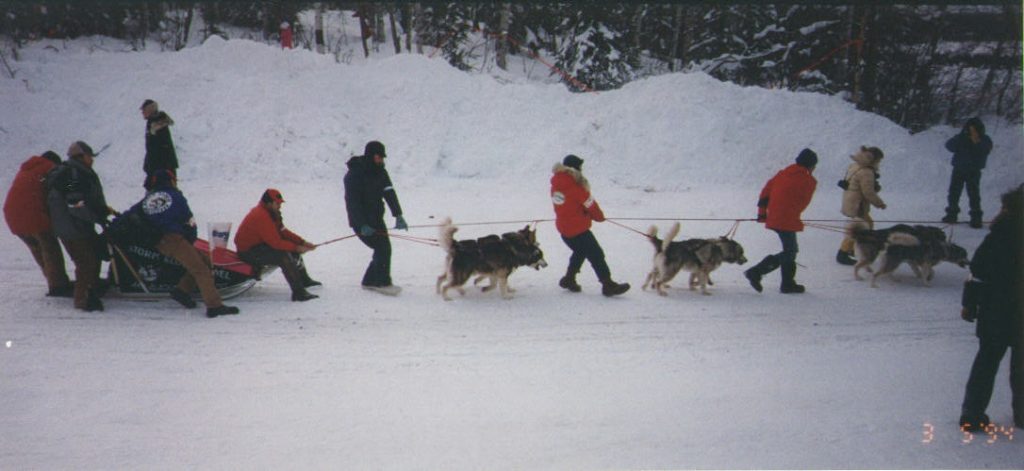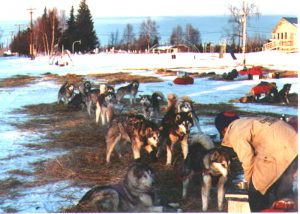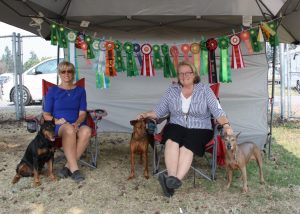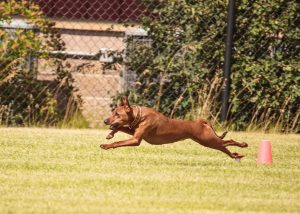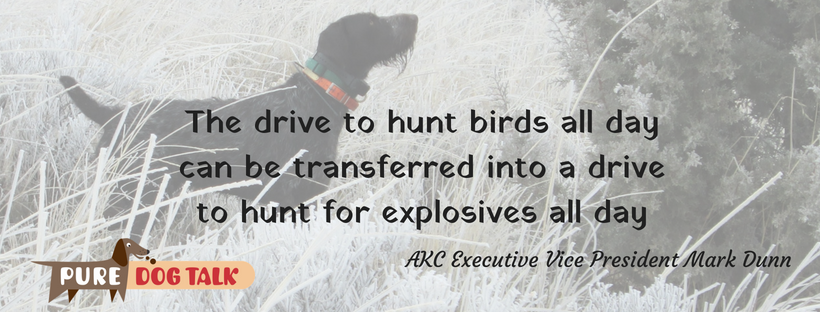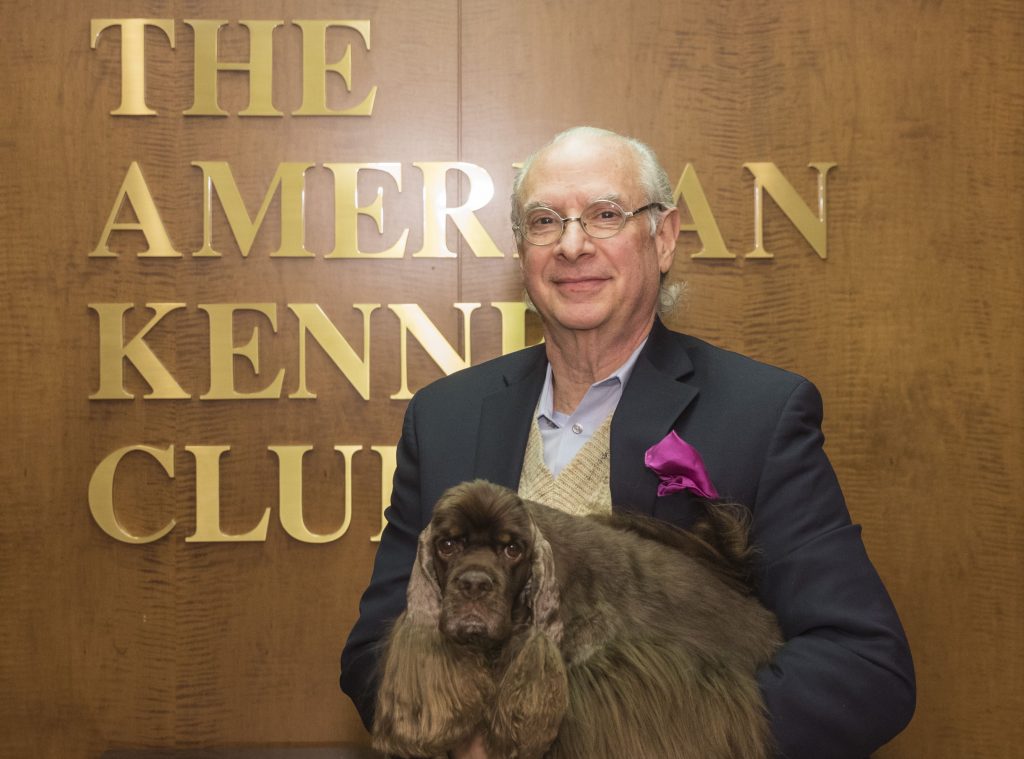239 – New School Programs Provide Kids with Facts and Fun
Public Education school programs reach out to the future
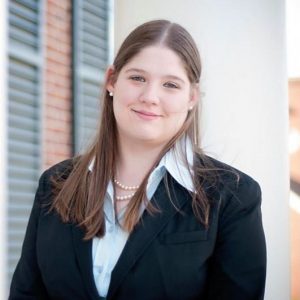 Ashley Jacot, recently promoted to Director of Education at the American Kennel Club, joins me to talk about the exciting school programs that AKC has developed in the last year.
Ashley Jacot, recently promoted to Director of Education at the American Kennel Club, joins me to talk about the exciting school programs that AKC has developed in the last year.
Jacot, a former school teacher, was hired in 2017 to lead the development of new programs for schools as an outreach to the public. She and her team have developed 10 new programs in 18 months.
“We are providing kids with a way to think about dogs,” Jacot said. “We’re giving them an alternative narrative to the “adopt don’t shop” mentality. They are learning the truth about purebred dogs and what we do. We provide facts and give them an amazing experience. They walk away and they have a different feeling about purebred dogs and AKC than they did when they got there.”

The Public Education department is continually producing lesson plans for K-12 that are aligned to national curriculum standards. Jacot said that today’s testing requirements mean they have to provide what teachers need. The lesson plans are rigorous, but reachable, she added.
“This really lets us open the curtain to the world of purebred dogs,” Jacot said. “People don’t know this world exists or they misunderstand what it is.”
Through these programs, AKC has made connections in communities, Jacot noted.

Learning about purebred dogs and dog shows.
“The running theme we found is the opportunity to make a lasting impact on students, teachers, families and entire communities,” Jacot said.
Lesson plans might include something like “compare and contrast breeds for tall and short in kindergarten. Compare the height of a Bichon to a Corgi, which taller by inches, in 3rd grade. And in an 11th grade lesson plan, the students are taught to use a Punnett square to learn inheritance of coat color,” Jacot said
Some of the programs implemented in the last 18 months include:
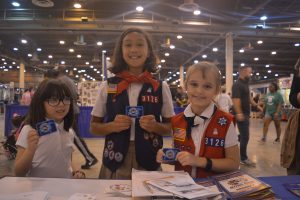
AKC Patch Program participants.
AKC Patch program. Public Education is hosting a program at AKCNC for the second year. Jacot said they had to close registration, with 446 children registered over two days. “We get to share the excitement of the dog show with these kids,” she added.
Art contests such as the one hosted by Portland’s Rose City Classic are also a huge hit with the community.
“We have so much work to do, we need more hands,” Jacot said. “We are growing and serving the fancy.”
Stick around for Allison Foley’s Tip of the Week from the Leading Edge Dog Show Academy about what and how to use stripping tools.
238 — The friendships and journeys of a successful owner-handler
Sealyham Terrier owner-handler at the 2018 Westminster Kennel Club
Olga Forlicz and Leslie Jaseph, Sealyham Terriers breeders, share stories about the international friendships and journeys of a successful breeder owner-handler.
Details matter
Jaseph shares her experience showing in the hyper competitive East Coast terrier groups, many of which are dominated by top professional handlers.
“You have to go in the ring with your dog trained and prepared like any other person in the ring,” Jaseph said. “You have to understand preparation and trimming. You can’t make an excuse. You and your dog have to be prepared.”
No excuses
Jaseph’s highly successful bitch was entered at Westminster Kennel Club, but she didn’t bring her because she wasn’t quite back to top condition from her litter of puppies.
“You have to have high standards,” Jaseph said. “Never bring your dog out unless you feel it can win.”
US versus Europe
Forlicz, who lives in Poland and is the breeder of Jaseph’s competitive bitch, compared European and American shows. She said that the general level of grooming and overall presentation is much higher here in the US.
“In Europe we have famous breeders, but not as many professional handlers,” Forlicz said. “It is maybe easier for the average person to compete at a high level.”
Forlicz added that while there are more shows in the US, Entries are typically much larger in Europe.
International partnership
Jaseph approached Forlicz to purchase a dog because she was “looking for something tightly bred, that phenotypically was a good match for anything in the US.”
Breeders should “Get out your ruler and measure the dog,” Jaseph said. “Compare it to standard, break it down.” She also noted that within style variations, balance is the key in the breed.
Her general assessment of the breed, although it is numerically threatened worldwide, is that overall coats and movement are good. Her observation is that breeders should pay attention to tailsets and the length and strength of heads.
The full-length video interview also is available at the Pure Dog Talk YouTube channel, here: https://www.youtube.com/watch?v=6qr5CEfpFIk
236 – CHF Research Examines Neurological Diseases
Epilepsy is the number one neurological problem in dogs
Dr. Diane Brown and the Canine Health Foundation are doing battle with neurological disease, specifically epilepsy, in an effort to improve the lives all dogs, and their people.

Dr. Diane Brown, CEO, AKC Canine Health Foundation.
“Epilepsy is a complex disease,” Brown said. “It presents in different ways. It is present in all dogs, mixed breed and purebred, and in people.”
Epilepsy is a catch all term applying to different breeds, different ages, different causes of seizures. “Idiopathic epilepsy” in layman’s terms means, “we don’t know why your dog is having seizures, but we’re calling it epilepsy.”
Brown notes that seizures can be caused by clearly genetic cases, toxicity, structural defects, inflammatory diseases, brain tumors and other underlying issues. Even more terrifying, up to one-third of epilepsy cases are noted to be resistant to current medication
“We really wanted to make a concerted, multi-year effort trying to address epilepsy in dogs,” Brown said. She added that the research effort is focused on two broad areas: genetics and developing new therapies for the disease.
Break throughs and new studies
A CHF funded grant has already identified a new dosing option for dogs with seizures causing an emergency situation.
“It’s been 20 years since a new drug was identified that can be used in an emergency situation,” Brown said.
Alternatives to standard therapies are also being studied. Brown highlighted a study into the effects of treatment with CBD oil in a large clinical trial with rigorous scientific standards. The research is the first of its kind in the country, and CHF was the first to invest in this exciting effort.
As other studies investigate gene identification, the most recent breakthrough was identifying a form of epilepsy in juvenile Rhodesian Ridgebacks that is directly related to pediatric epilepsy in humans.
While the goal is to develop a DNA test for epilepsy, Brown notes that genetics are complicated and it’s rarely as simple as identifying one gene to breed out of a population.
An even more fascinating study is examining the role of the intestinal tract, the so-called gut-brain axis, that may have influence on neurological health
“We are for the health of ALL dogs. It can create a false impression that purebred dogs are less healthy, but the reality is, they are the ones who contributed to the funding to solve the problem,” Brown said.
CHF Epilepsy Research Initiative, includes grants, research publications, webinars, other resources
Epilepsy white paper:
http://www.akcchf.org/canine-health/top-health-concerns/epilepsy/understanding-canine-epilepsy.html
CHF-funded research study on CBD for drug-resistant epilepsy in dogs
http://www.akcchf.org/research/research-portfolio/2323.html
Webinar with veterinary neurologist, Dr. Karen Munana:
https://www.vetvine.com/article/376/akcchf-update-on-canine-epilepsy
CHF press release
http://www.akcchf.org/news-events/news/clinical-trial-to-study.html
AKC article
https://www.akc.org/expert-advice/health/alternative-medicine/cbd-oil-for-dog-seizures/
Pure Dog Talk‘s interview with Liz Hansen on epilepsy research.
234 – Raising Support for the K9 Reproductive Specialists of the Future
Supporting reproductive specialists for the future of our dogs
Reproductive specialists in veterinary medicine are known as Theriogenologists. In a world where spay/neuter is the “popular” approach to veterinary care, the Theriogenology specialty was on the verge of collapse. The American Kennel Club and Canine Health Foundation have joined forces to support these “OB/GYNs of the dog world.”
Many breeders know the frustration of trying to find a modern veterinarian who will work with them in developing their breeding programs. Dr. Diane Brown, CEO of Canine Health Foundation shares her insight on this forward-thinking collaboration to promote and encourage canine reproduction veterinary specialties.
“There are a limited number of board certified practitioners in Theriogenology,” Brown said, “And most of them are in the large animal industry.”
The AKC/CHF Theriogenology Initiative grew out of a collaboration between AKC and the Theriogenology Foundation to provide funding to vet schools to train new practitioners in reproductive medicine for dogs.
Brown noted that many veterinary schools have not emphasized reproductive medicine for companion animals and students have expressed less and less interest in the field.
“Schools are teaching vet students to spay and neuter and sending them out into the world,” Brown said.
Getting out Front
The Theriogenology Residency Program, developed by CHF, enables AKC and the purebred dog fancy to get in front of the curve, encouraging and supporting vets who want to train for specialized work in therio.
“We’re already seeing an increase in dialogue, raising of awareness, involvement of breeders,” Brown said. “They’re all coming together. It’s bringing people around the same table to talk about this. Local breeders are working with students. Residents are working with local breed clubs.”
Ongoing residencies since 2016 have been awarded to universities through a competitive process in which grant proposals submitted. The proposals undergo a rigorous scientifically reviewed process competing for this money.
A 501c3 non-profit, CHF enables purebred dog enthusiasts to support this program directly by donating and designating the Theriogenology Residency program. Literally 94 cents of every dollar goes to actual research programs that meet the mission, Brown said.
AKC Canine Health Foundation:
Article in Dog News by Sue Copeland about the “theriogenology residency program”:
http://ebooks.dnmagazine.us/volume_03/issue_08/dnm.html#p=52
Article on most recent residency awarded at Virginia Tech:
https://vtnews.vt.edu/articles/2018/09/vetmed-theriogenology-2018.html
CHF/Today’s Breeder article highlighting the 2016 class of residents:
http://www.akcchf.org/educational-resources/library/articles/a-dog-breeding-roundtable.html
233 – AKC’s Team Scores on Detection Dog Legislation
AKC’s Detection Dog Legislation Promotes Purpose Bred Dogs
Sheila Goffe, AKC Vice President Government Relations, joins me for a conversation about legislation and the old adage about law making and sausage making.
TSA came to AKC to address shortage of detection dogs in the USA several years ago. Dr. Carmen Battaglia led the development of the Detection Dog Task Force. The first legislation AKCGR worked on in this area was passed last year and required the government to provide a report on comparative expenses of acquiring dogs from overseas for this critical work. (Check out my interview with Mark Dunn from last year on that topic!)
Meanwhile, AKCGR and the Detection Dog Task Force have not rested on their laurels. Goffe has worked for years to establish relationships with legislators and create an “honest broker” reputation that came to fruition again this fall.
Passing new legislation
Congressman Mike Rogers (R-AL) sponsored the Domestic Explosives Detection Canine Capacity Building Act which easily passed the House and then stalled in the Senate. By attaching the bill to a “must pass” funding reauthorization, Goffe and her team were able to assure passage of this new legislation which creates a Public-Private working group to develop a decentralized breeding network.
National Purebred Dog Day/Canines at the Capitol Event in 2017, with the award honoring the US Capitol Hill K9 Corps
Goffe said the very best part of the Congressional hearings was when a New York Congressman stood up and said, “We just need to breed more dogs.” This acknowledgement and support of purpose bred dogs and the breeders who create them at a legislative level is a huge leap forward, Goffe noted, in our ongoing battle to ward off anti-breeder sentiment.
This legislation ensures that US breeders will have access to support in building the best dog for the job of explosives detection. These dogs are high drive, stable minded, physically sound and have intense work ethics, Goffe said.
This team comprised of AKC, TSA, research universities and national experts in training, contracting, breeding will create a baseline of behavioral, medical, and technical standards for explosive detection dogs. Goffe is hopeful this can be accomplished before the end of 2018.
“This effort supports good breeders, is important to national security and is all about purpose bred dogs,” Goffe said.
Allison Foley stops by also with her Tip of the Week from the Leading Edge Dog Show Academy on dryer sheets and how they can be used effectively in the winter months!
231 – Researching Connections Between Ticks and Cancer, Other Disease
Research shows growing problem with ticks
Ticks are creepy crawly creatures we all love to hate. But they are also dangerous disease vectors transmitting deadly organisms. Dr. Diane Brown, CEO of the AKC Canine Health Foundation, shared incredibly
valuable information about what her organization is doing to lead the fight against these diseases.
CHF funded research has identified a class of tick-borne organisms, called Bartonella. Bartonella invades the host’s blood vessels and can cause inflammation in the heart.
“What if that (bartonella infection) is the early trigger that leads to chronic inflammation in the blood vessels,” Brown posits, “potentially leading to the development of cancer.”
Current CHF funded research is looking at bartonella in association with hemangiosarcoma, literally cancer of the blood vessels.
“It’s a little controversial,” Brown said “but there’s a lot of impetus driving the research in this direction.”
Tick-borne organisms associated with deadly disease
The Foundation’s research also has shown immune mediated hemolytic anemia can be associated with tick borne disease.
“It’s critical to test these dogs for an underlying tick borne infection before treating them with steroids that can just exacerbate the problem,” Brown said.
The CHF initiatives are working on broad spectrum of vectors that impact the health of dogs, Brown noted. She added that new tick species and diseases are discovered every year.
“Tick preventives are key to keeping your dog healthy,” Brown said. With the rising number of “co-infections” she noted that testing for more than one disease is imperative.
CHF has a three-prong approach to this burgeoning crisis. The non-profit funds research focused on diagnosis, new therapies for treatment and prevention.
Hear more on this topic with CHF Board Member Susan Hamil:
Additional Resources from CHF:
CHF Tick-Borne Disease Research Initiative landing page; includes grants, research publications, webinars, podcasts, news, and other resources
White paper:
http://www.akcchf.org/canine-health/sporting-field-dogs/Tick-borne-Disease.pdf
Lyme Disease Fact Sheet:
Ticks and Zoonotic Disease Webinar with Dr. Ed Breitschwerdt:
https://www.vetvine.com/article/274/akcchf-tick-borne-diseases-event
Diane Brown, DVM, PhD, Dipl. ACVP, is the Chief Executive Officer and Chief Scientific Officer for the AKC Canine Health Foundation (CHF). She joined CHF in August 2015, and oversees operations and scientific programs from its Raleigh, NC headquarters. Her role is to cultivate and execute the Foundation’s research and education strategy in collaboration with its Board of Directors, Scientific Review Committee, external collaborators, principal investigators and staff to ensure strategic, responsible, and innovative application of donor funds to uphold the Foundation’s Mission to advance canine health.
Dr. Brown is a board-certified veterinary clinical pathologist who holds a DVM and PhD in pathology from Colorado State University. As an independent investigator and comparative pathologist, Dr. Brown served as a member of the faculty at Harvard Medical School, as director of the Comparative Clinical Pathology Laboratory at Massachusetts General Hospital, and as consulting pathologist at the University of Colorado. She previously served as Chief Scientific Officer for Morris Animal Foundation, and currently holds an affiliate faculty position in the Department of Molecular and Comparative Pathobiology at Johns Hopkins University School of Medicine. She has held prior affiliate faculty appointments in the veterinary schools at Tufts Cummings School of Veterinary Medicine, Colorado State University and Purdue University.
230 – Storm Kloud Alaskan Malamutes: Continuation of a Dream
Storm Kloud team of Alaskan Malamutes proved their heritage in 1994
After two years and 3,000 hours of training, Nancy Russell’s Storm Kloud Alaskan Malamutes were ready to compete in the iconic Iditarod Race in 1994.
Russell shares her stories of this epic journey, noting that she was proud to show that “Our dogs can still go on and do what they were bred to do.”
Twenty below for eight days
Russell and her crew drove with the five females and 10 males, all but one bitch intact, that made the final team. “It was 20 below zero when we left Minnesota. And it never got above that for eight days, all the way to Alaska,” Russell said.
“There was no snow in Anchorage,” Russell said “so they hauled in snow and put enough on the street to run the teams 15 blocks. Because a driver would not be able to set a snow hook if they had trouble with a team, an extra person had to ride with them. Therefore I got to ride in the sled for the ceremonial start of 15 blocks that year. Jamie chose 5 Champions and Josh to run as only 6 dogs were allowed in the team.”
Dog aggression was a major concern for the race organizers, Russell noted. The Alaskan Malamutes of the day were considered very “tough.” Part of the hours of training was that “we had to be sure the dogs could pass (another team of dogs) without causing problem before would be *allowed* to run this team,” Russell said.
Show dogs to team
Another obstacle, Russell said, is that the “show dogs” had to learn to be part of a team. Of the 15 dogs on the team, 11 were or became show champions.
“Show dog is not a team event,” Russell said. “Going from ‘I am the coolest’ to teamwork was a huge issue for Jamie (Nelson, the professional musher who trained and ran the team) to overcome. She had a hard time getting the dogs past people with cameras… the dogs were so convinced they were cool…”
Russell was amazed that the dogs actually gained weight along the route of the race. She noted that the dogs would push away the straw put down for bedding and held up well in the arctic environment of their heritage.
Danger on the trail
“When Jamie arrived at Finger Lake she went into a Dodge Lodge (tent furnished for the mushers) to sleep,” Russell said. “Later she woke as she was cold and went to get her sleeping bag. She was unable to stand and crawled out and then realized they were being asphyxiated from the stove. She crawled back in and turned it off and tried to wake the other mushers but could not wake them. She called for help and Beth Baker MD who was in the checkpoint heard her and they got them out. Jamie and Beth received the Sportsmanship award for saving the lives of the other four mushers.”
Eskimo welcome
The native people were thrilled when the team arrived near their communities.
“When they got to the Eskimo villages, the school teachers let kids come out of school to see the Malamutes,” Russell said. “One elderly gentleman came and brought his grandkids. He said ‘you have to see these dogs. This is what we used to have.’”
The struggle, Russell said, was the dogs’ feet. The weather was unusual that year, she noted, with rising temperatures causing rivers to melt.
“The dogs went through the river,” Russell said, “but the conditions caused a number of dogs to have feet susceptible to injury.”
Feet are the foundation
Despite special boots designed for the dogs, the team was struggling with ice balls in their pads and swollen feet in the boots.
“I do feel people are breeding smaller, tighter feet because they are pretty, not because they are functional,” Russell said. “The snowshoe foot, as described in the standard, doesn’t look as nice in the show ring.”
The dogs’ feet were what caused them to end their run after 640 miles of the 1,500 mile race, Russell said.
“Here I was in Ruby, more than halfway through the race, trying to make the decision. The dogs’ feet had gotten progressively worse in the last 300 miles. When I bootied them they swelled up. When I ran without, they snowballed within a few miles. The vets and I had tried everything we knew. I was running out of options. It seemed such a shame. For the most part, their bodies were like fine-honed machines. They could easily have completed the course. Only their foot problems were to let them down. Yet they were the feet that had carried me close to 600 miles in less than seven days through some of most rugged country Alaska had to offer. To take advantage of their willingness to please and push them on in their condition wouldn’t give us any more answers, only serve to inflict unnecessary pain. I thought back now to the time we had spent training together. I had worked with some these guys for four years and trained intensely for the better part of the last two years. They had taxed every bit of my knowledge on training. They had tried me every step of the way and through this I had grown to love these guys. But, it wasn’t just love I was feeling now, it was something else. They had developed a trust in me, a trust that I would always do what ‘s right for them. A bond of trust that is stronger than love or even life itself, a trust that once broken can never be regained. I went back and took another look at their feet, then I looked into their eyes, and the decision was made.” — Musher Jamie Nelson
By any calculation, 15 show dogs running in harness for 640 miles in the brutal arctic conditions is a tremendous accomplishment. Russell remains proud of her dogs’ ability to prove the breed can still do its job in the most extreme conditions. Listen to part one of this story here.
227 — German Pinscher: All-Purpose, Robust Dog for Active Owners
German Pinscher is up for anything, but not for everyone
Valerie Vihlen Schluter, left, and Janet Oatney, right, show off their winnings and their dogs at the GPCA national specialty in Washington.
I visited with German Pinscher fanciers at the GPCA national to learn about this ancient breed. Valerie Vihlen Schluter and Janet Oatney were kind enough to share their enthusiasm and words of advice for potential owners.
German Pinschers date to the 1800s. This family farm dog was the foundation for Doberman Pinschers and Minature Pinschers. They are also split off as the “smooth coat” variety of the dogs that became the Standard Schnauzer. In fact, in Germany to this day, Oatney said, the Pinscher Schnauzer club remains united.
Like so many other purebred dogs, the German Pinscher was salvaged after the devastation of WWII. Werner Jung, the breed warden, smuggled a GP bitch out of East Germany and mated her with oversized Miniature Pinschers to establish the modern breed.
A Ferrari vs a Cadillac
“These dogs are competitive in all kinds of sports,” Oatney said. “They take an experienced dog owner. They are not a good breed for the first-time dog owner.”
Ferrari and Cadillac are both great cars, Oatney offered as a comparison. “These are like the Ferrari of dogs… You need to be on your toes.”
Vihlen Schluter also noted that because the breed is so in tune with its owners, they can make excellent service and therapy dogs. In this arena, the breed boasts a FEMA certified disaster assistance dog that dispatches to disaster areas to comfort victims.
The German Pinscher Club of America has excellent resources available at https://germanpinscher.org/
From the national club:
A Working Dog of Great Intelligence
An ancient breed of great intelligence and high energy. They are medium sized and robust with a strong prey drive. Alert and intelligent, they are outstanding performance dogs as well as companions with an instinctive drive to protect home and family. Because of their strong will, intelligence and independent nature, obedience training is a MUST!
AKC Standard
The German Pinscher is a medium size, short coated dog, elegant in appearance with a strong square build and moderate body structure, muscular and powerful for endurance and agility. Energetic, watchful, alert, agile, fearless, determined, intelligent and loyal, the German Pinscher has the prerequisites to be an excellent watchdog and companion.
Allison Foley, Leading Edge Dog Show Academy, offers her Tip of the Week on using available classes to best showcase your individual dog.
And learn more about Trupanion’s “breeding rider” insurance policy with Harin Greer.
Don’t forget to check out Pure Dog Talk’s new online store for great swag!
209 – Made in the USA: Breeding Our Own Bomb Dogs
Bomb Dogs: Purpose bred, purpose raised, purpose trained
Mark Dunn, AKC’s Executive Vice President, has been leading the charge to develop a program to produce purpose bred, purpose raised and purpose trained dogs domestically for explosives detection work.
“There is a growing demand for dogs who can help protect us,” Dunn said. “It is driven by companies and organizations, as well as police and military. Universities, arenas, sports leagues – they are all requiring detection dogs to clear the venue ahead and work the crowds.”
All of these dogs are currently coming from eastern Europe, Dunn noted. United States military and independent contractors acquire 80-90 percent of their bomb detection dogs from the same countries where the entire world shops.
“We’re trying to outbid Saudi Arabia or Israel or Indonesia to buy dogs from these kennels in Europe,” Dunn observed.
In our first conversation with Dunn, he outlined the goal of developing breeding programs in the U.S. to protect our country.
“We have to find a way to bridge the gulf between the U.S. breeders and people training the dogs to do the work,” Dunn said. “U.S. breeders don’t raise dogs for anyone but themselves. Generally, our breeders don’t raise a puppy to 10-12 months to sell.”
The government is looking for a dog that’s ready to do the work, Dunn added. The dogs need key skills – a high hunt drive, environmentally stable, accustomed to noises and moving objects. These need to be well-socialized and exposed puppies who grow up to be confident and capable dogs.
AKC has created a task force and a conference to bring all of the stakeholders together.
“This is a great example of how purposeful, thoughtful breeding by American breeders can help protect our country,” Dunn said. “It highlights the important role that purebred dogs play in our country and it reflects well on ALL breeders who are thoughtfully and purposefully breeding dogs.”
One of the potential stumbling blocks, Dunn agreed, is the question of what happens to dogs that don’t make it. What happens when a dog’s useful working life comes to an end?
“It’s important that AKC play a role in this,” Dunn said. “No one has answered that question well yet. And parent clubs and fanciers are asking it. We can get those sort of things in place. There should be a way for me to breed a dog, deploy it to this important work. And still be able to have a first right of refusal at the end of it’s career. These dogs often retire with their handlers. But, as a breeder, I would want to be able to play a role in the dog’s future.”
Update on the AKC US Detection Dog Taskforce.
- Since 911 the demand for Explosives Detection Dogs has steadily increased.
- Recent attacks are accelerating the push to deploy more dogs and worsening the supply problems
- 80% of detection dogs used to protect our country and our overseas interests are from Eastern Europe
- Experts agree that the US is not getting enough dogs and that the dogs we get are not the best
- Demand is coming from State and Local Governments, Universities, Corporations, Entertainment Venues in both the developed and developing worlds.
- It is understandable that many “pointy eared” dogs come from Europe
- However, new demand is for Sporting breeds and these are also being sourced in Europe instead of leveraging US capacity and aptitude for these breeds.
- Sporting dogs are preferred for the public detection work over the patrol type breeds for several reasons, including:
- Less intimidating to the public
- Less reactive when used in close quarters for personal searches
- Drive to hunt birds all day can be transferred into a drive to hunt for explosives all day
- Some shelter dogs can do the work, but due to high training costs and washout rates, the recipe for success is:
-
Purpose Bred
-
Purpose Raised
-
Purpose Trained
- The AKC Board formed a Taskforce to address the domestic detection dog supply crisis in 2016
- The Taskforce has focused on the following tactics:
- Using AKC Gov’t Relations and Public Relations to impact awareness and policy
- Networking and collaborating with all stakeholders interested in the detection dog crisis includingbreeders, AKC Parent Clubs, trainers, brokers, gov’t employees, researchers and other academics
- Establishing AKC as the hub for all stakeholders, including the development of the AKC Detection Dog Conference
- Exploring the development of model breeding and puppy socialization program specifically targeting the need for explosive detection dogs
- Establishing a database for US detection dogs, including genotyping and the collection of phenotype information such as certifications or other measures of capability
Allison Foley’s Tip of the Week from the Leading Edge Dog Show Academy Training dogs to walk in a straight line and leash/collar placement.
192 – AKC President Dennis Sprung on Public Outreach
AKC President Dennis Sprung on Public Outreach
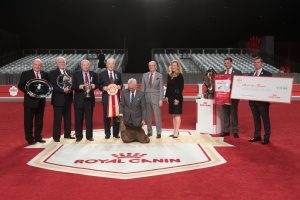
AKC President & CEO Dennis Sprung joins the presentation of BIS at the 2017 AKCNC in Orland, Fla.
President and Chief Operating Officer of the American Kennel Club since 2003, Dennis Sprung has ardently pursued projects designed to share the message of the human-canine bond.
Starting in dogs with the Afghan Hounds of Grandeur in the late 1960s, Sprung was mentored by the legendary Sunny Shay. Shay laid the foundation for his education in dogs, Sprung said. At a time when the famous Long Island kennel housed over 100 dogs, he routinely interacted with everything from puppies to veterans.
Inspiring Dreams for Everyone
“She was one of a kind,” Sprung said. “A true character in the sport. Sunny was unique, in many ways, but particularly in that she was a Breeder Owner Handler. Shirkhan’s first BIS in 1957 was at Westminster Kennel Club.” (For more history and stories about Sunny Shay and the Grandeur Afghans, listen to Michael Canalizo at https://puredogtalk.com/canalizo-ghosts-of-the-past-and-breeding-for-the-future-pure-dog-talk/)
Sharing the Human-Canine Bond
Shortly after Sprung started working for AKC as an Executive Field Rep in 1989, he proposed to the Board of Directors the program that became the AKC Humane Fund. His vision was to create an additional vehicle to serve as outreach to the public, sharing the message of the human-canine bond. The AKC Humane Fund has now grown to include grant making for parent club breed rescue, scholarships, funding for domestic violence shelters that allow pets and assistance in cases of natural disaster. (https://www.akchumanefund.org/)
Art as Outreach
Sprung is involved with the AKC Museum of Dog as a member of original planning committee and former board member. He is actively working with AKC staff to help the museum move back to NYC from its location near St. Louis, Missouri for the last 31 years. “The museum is one of the finest collections of sporting art in the world. It pays respect to our breeds and our traditions in the sport. With a location one block from Grand Central terminal, where they have 22 million visitors annually, the opportunity to grow purebred dogs is endless.” (https://www.akc.org/museum-of-the-dog/)
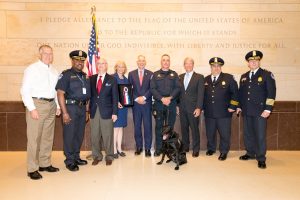
Sprung joins a presentation for working K9s.
On the night following the 9/11 attacks, Sprung had a brain storm.
“AKC was able to donate a portable x-ray machine and a large quantity of supplies,” Sprung said. “These were delivered by me to Ground Zero, on that very corner with smoke still rising… I’ll never forget that.”
He resolved to create a public art exhibition and fundraising opportunity. From this was born DOGNY. Honoring the search & rescue dog and handler teams, 112 dog statues were placed around New York City. In all, more than $3.5 million was raised for Search & Rescue groups nationwide. (https://www.akc.org/dogny/)
“I have to tell you. Credit goes to our entire fancy,” Sprung said. “Springfield Kennel Club was the first donor. Corporate America came through and worked with us, but our fancy was with us every step of the way.”
Building from that concept, AKC Reunite was developed, spearheaded by Delegate Pat Laurans.
“The AKC family is providing what’s needed to save dogs throughout the country,” Sprung said. The fundraising effort has placed 67 trailers across the nation. (http://www.akcreunite.org/)
“I think one of the most important things we can do is to not only look inward, but also look outward,” Sprung said. “We need to focus on our core constituency, on our mission of registration and events. But we also have to communicate with the public. We have to educate them. Be consistent in our messaging. Be transparent and continue to do the right thing. …There’s many societal changes that are affecting all of us. We’ve lost a lot of sites (for dog shows). This is no longer rural America. We have to address the fact that there are a number of territories that no longer offer point shows. We have to continue to work together.”

